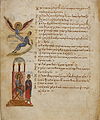Category:Theodore Psalter
11th century manuscript psalter | |||||
| Upload media | |||||
| Instance of | |||||
|---|---|---|---|---|---|
| Full work available at URL | |||||
| Collection |
| ||||
| Inventory number |
| ||||
| Inception |
| ||||
| |||||
The Theodore Psalter (British Library Additional MS 19352) is one of the most famous illuminated manuscripts to survive from the Byzantine Empire. Completed in Constantinople in February 1066, the Psalter consists of 208 folios which include 440 separate images, making it the most fully illuminated Psalter to come down from Byzantium. It is undeniably one of the greatest treasures of Byzantine manuscript production and of supreme importance for our understanding of Byzantine art.
Two centuries before its production, the iconoclastic movement had been defeated, making representational art obligatory for divine worship. From that time onwards the art of icons once again flourished. It is within this context that the Theodore Psalter should be understood.
The Psalter contains 151 Psalms (ff. 1-189), a twelve-syllable poem on David’s early life in the form of a liturgical drama, in dialogue, based on Psalm 151 (ff. 189v-191), a prayer offered on behalf of Abbot Michael (ff. 191v–192), the Canticles (ff. 192v–208), as well as a dedication and colophon (f. 207v and f. 208). The Psalms and the Canticles are numbered next to their titles and the Psalm text is divided between kathismata and staseis, according to liturgical practice. A plethora of initial letters is ornamented.
- See more at: http://britishlibrary.typepad.co.uk/digitisedmanuscripts/2012/03/the-theodore-psalter.html#sthash.3exH30Lx.dpuf
Media in category "Theodore Psalter"
The following 21 files are in this category, out of 21 total.
-
Psautier-de-Théodore.jpg 310 × 233; 26 KB
-
Theodore Psalter - Adoration by the Magi.jpg 500 × 595; 104 KB
-
Theodore Psalter - Praising singing, ps 148. 5-14.jpg 3,843 × 4,499; 3.97 MB
-
Theodore Psalter 001.jpg 236 × 321; 34 KB
-
Theodore Psalter 01.jpg 768 × 916; 562 KB
-
Theodore Psalter 03.jpg 768 × 951; 536 KB
-
Theodore Psalter 04.jpg 768 × 901; 565 KB
-
Theodore Psalter page 011v. Ps.11.4-6 David at Lord's throne.jpg 3,845 × 4,597; 4.43 MB
-
Theodore Psalter page 099r Ps 76.17 Baptism of Christ.jpg 4,275 × 3,539; 3.48 MB
-
Theodore Psalter page 099v. Ps.76.21 - Moses and Aaron.jpg 3,798 × 4,678; 5.16 MB
-
Theodore Psalter page 106r. Ps.77.68 annoing of David.jpg 3,799 × 4,505; 4.37 MB
-
Theodore Psalter page 118v.Ps.88.21 Annoing of David.jpg 4,264 × 3,055; 2.87 MB
-
Theodore Psalter page 127r. Ps.94.1.jpg 3,860 × 4,640; 4.53 MB
-
Theodore Psalter page 134r. Ps. 101.7.jpg 4,163 × 4,112; 3.52 MB
-
Theodore Psalter page 157v Entry into Jerusalem.jpg 4,232 × 3,115; 2.74 MB
-
Theodore Psalter page 189v, Ps. 151.jpg 3,710 × 4,690; 4.66 MB
-
Theodore Psalter page 190r Samuel and David.jpg 3,866 × 4,695; 5.21 MB
-
Theodore Psalter page 191r Ps.151. 7-8 - David killing Goliath.jpg 3,703 × 4,545; 4.54 MB
-
Theodore Psalter, Pslam 26, 1066.jpg 630 × 775; 622 KB
-
Theodore Psalter. Gregory brings Tiridates to Christ.jpg 1,259 × 1,080; 273 KB
-
TheodorePsalter 137r 1.png 483 × 617; 875 KB





















